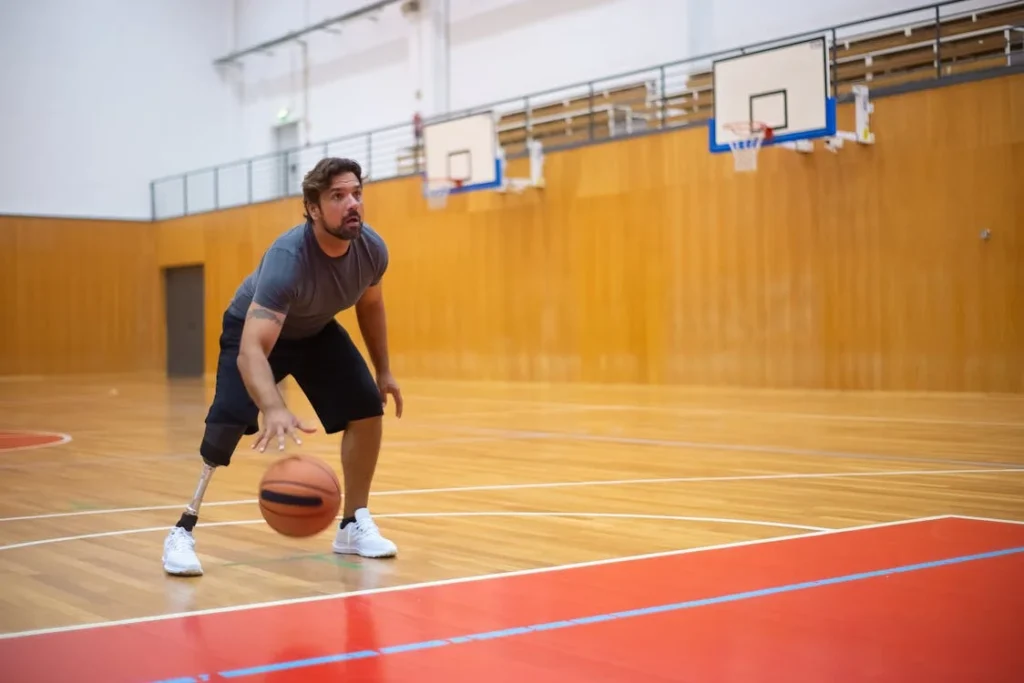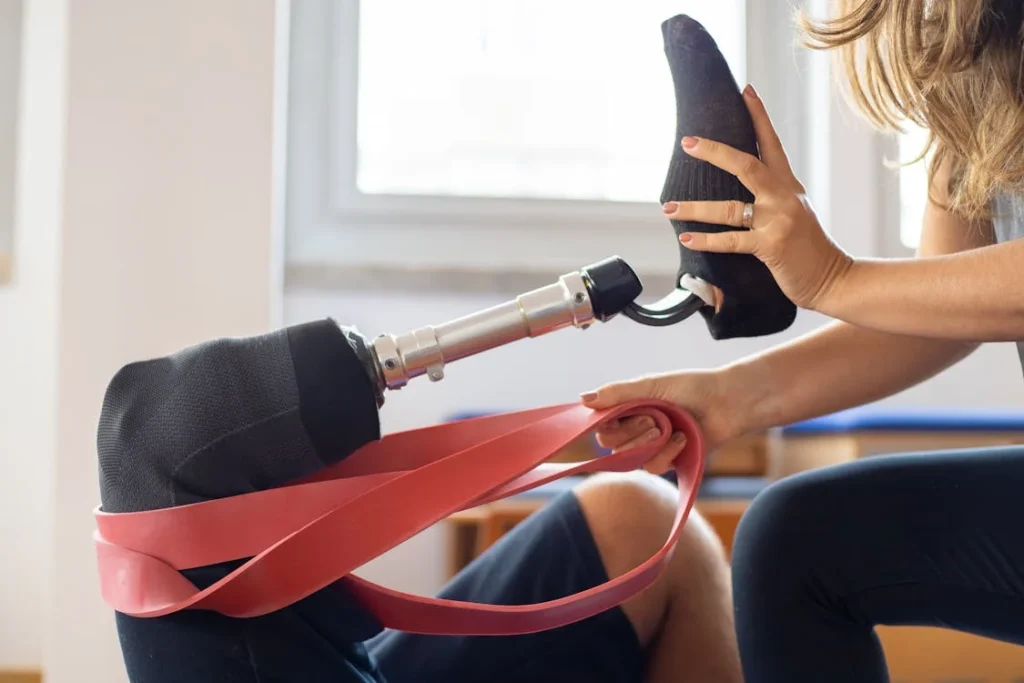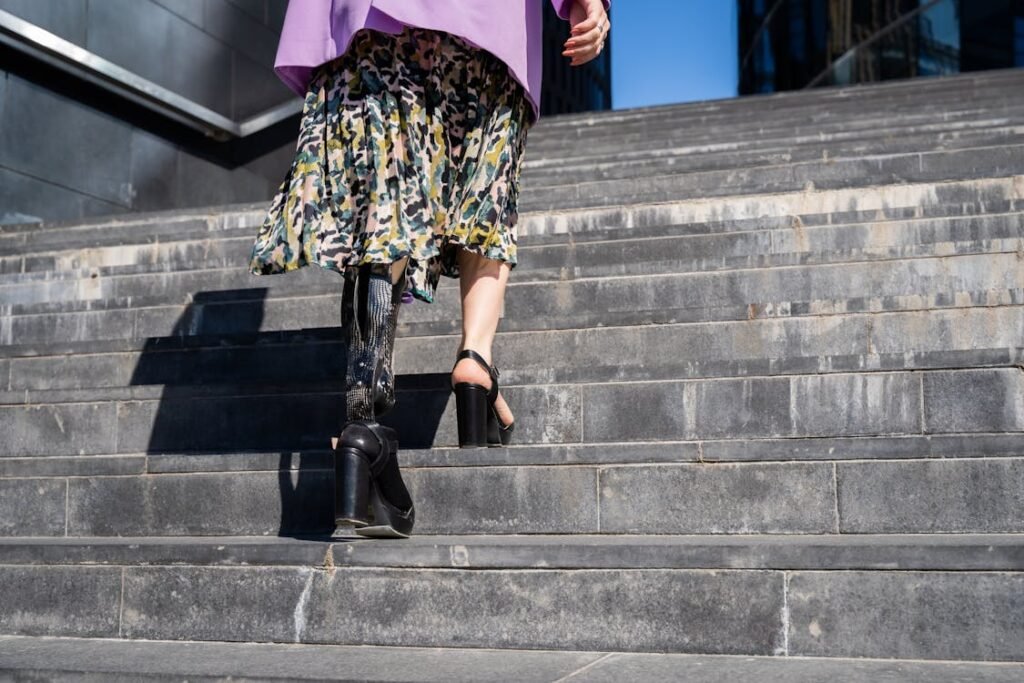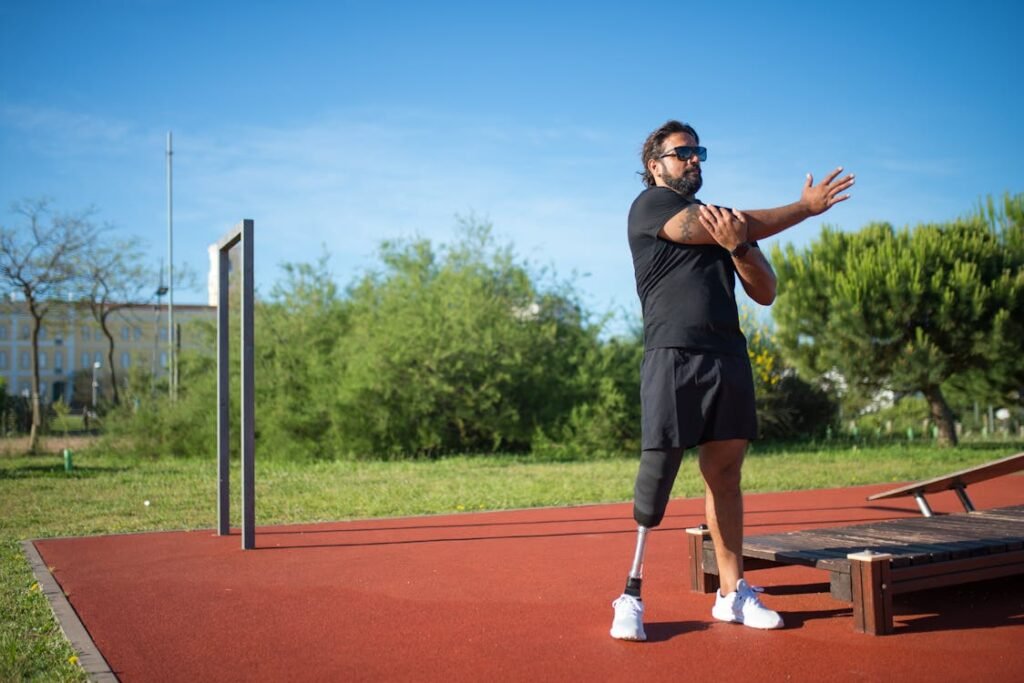Losing a limb is life-changing, and for those who undergo a hemipelvectomy—where part of the pelvis and the entire leg is removed—finding the right prosthetic solution is essential for regaining mobility. Unlike standard leg prosthetics, a hemipelvectomy prosthesis has unique challenges. One of the biggest concerns is suspension—how the prosthesis stays attached to the body securely while allowing comfort and ease of movement.
A well-designed suspension system ensures that the prosthesis stays in place without causing pain, pressure sores, or skin irritation. Since a hemipelvectomy prosthetic lacks a natural stump for attachment, it relies on other parts of the body, like the waist, abdomen, and remaining pelvis, to hold it in place. Different suspension systems offer different benefits, and choosing the right one can significantly impact mobility and comfort.

Understanding Suspension in Hemipelvectomy Prosthetics
Suspension is the foundation of any prosthetic system, but in hemipelvectomy cases, it becomes even more critical. Since there is no residual limb to act as a natural anchor, the prosthesis must rely on other methods to stay attached to the body.
The challenge is to create a system that provides a secure fit without causing discomfort, limiting mobility, or interfering with daily activities.
The Role of Suspension in Comfort and Functionality
A good suspension system does more than just hold the prosthesis in place. It directly affects how natural the prosthetic feels when walking, sitting, and performing everyday tasks.
If the suspension is too loose, the prosthesis may shift, causing instability and discomfort. If it is too tight, it can lead to pressure sores, skin irritation, and restricted movement. Finding the right balance is essential.
For individuals with a hemipelvectomy, the suspension system needs to compensate for the missing hip joint and thigh. This means distributing weight evenly while ensuring that the prosthesis does not move excessively when in use.
A well-fitted suspension system reduces energy expenditure, making walking less tiring and more efficient. Since wearing a prosthesis for extended periods is common, comfort must be prioritized to avoid long-term issues such as muscle fatigue and skin breakdown.
How Suspension Affects Mobility and Independence
The goal of any prosthetic device is to restore mobility and independence. Without a reliable suspension system, even the most advanced prosthetic limb will be ineffective.
Stability is key, especially for individuals who want to move confidently on different terrains, climb stairs, or even engage in light physical activities.
A poorly designed suspension system can create unnecessary movement between the prosthesis and the body, leading to difficulty in walking smoothly.
This instability forces the user to compensate by altering their posture or gait, which can cause strain on the lower back and remaining limbs. Over time, this can lead to chronic pain and joint problems.
A well-secured prosthesis allows the user to move naturally, improving balance and reducing the risk of falls.
Additionally, ease of use is a crucial factor. If the suspension system is too complicated or time-consuming to put on and remove, it can discourage regular use of the prosthetic.
A suspension system should be easy to handle, especially for individuals who may have limited hand dexterity or require assistance in donning their prosthesis.
Common Challenges with Hemipelvectomy Suspension Systems
One of the biggest challenges in designing suspension systems for hemipelvectomy prosthetics is ensuring a secure fit without causing discomfort.
Since the prosthesis is supported by the waist and remaining pelvis, pressure points can develop if the suspension is not properly adjusted.
Skin irritation is another common issue. Since the prosthetic socket covers a large surface area of the body, excessive heat and sweat buildup can occur, leading to rashes or skin breakdown.
Using breathable materials and proper padding can help minimize these problems.
Another challenge is weight distribution. A hemipelvectomy prosthesis can be quite heavy, so the suspension system must evenly distribute the load across the body.
Uneven weight distribution can cause strain on the lower back, leading to discomfort and fatigue. The design must take into account both comfort and functionality, ensuring that users can wear their prosthetic for long hours without feeling burdened.

Types of Suspension Systems for Hemipelvectomy Prosthetics
Choosing the right suspension system is one of the most important decisions for a hemipelvectomy prosthesis user.
Since the prosthetic limb does not have a natural stump to attach to, the suspension system must provide stability, comfort, and ease of use.
Different suspension methods offer unique advantages, and the best option depends on factors such as activity level, body shape, and personal comfort preferences.
Belt and Harness Suspension
One of the most traditional methods of suspending a hemipelvectomy prosthesis is through a belt or harness system.
This method wraps around the waist and pelvis, securing the prosthesis in place using straps and fasteners. While this system is relatively simple and adjustable, it has some drawbacks.
Comfort can be an issue, especially if the straps are too tight or cause pressure on sensitive areas. Since the harness covers a large portion of the waist, it can also become hot and uncomfortable, particularly in warm weather.
Additionally, some users find that the straps restrict movement, making activities like bending or sitting less comfortable. However, for those who prioritize ease of adjustment and a straightforward attachment method, a belt or harness system can be a reliable option.
Suction Suspension Systems
Suction-based suspension is a more modern and secure method for keeping a prosthetic limb in place. This system uses a vacuum seal to create suction between the prosthetic socket and the wearer’s body.
A one-way valve ensures that air is removed from the socket when the prosthesis is donned, creating a snug and stable fit.
One of the biggest benefits of suction suspension is the even distribution of pressure, which helps prevent irritation and pressure sores.
Since the prosthesis stays in place without the need for bulky straps or belts, users often report a greater sense of freedom and comfort. The tight fit also reduces movement within the socket, making walking feel more natural.
However, suction suspension systems require a precise fit. If the socket is too loose, the suction won’t hold properly, causing the prosthesis to slip. If it’s too tight, it can create discomfort and restrict circulation.
Additionally, some users find that putting on a suction-based prosthesis takes more time compared to other systems. Despite these challenges, many individuals prefer suction suspension for its superior stability and comfort.
Hip Joint and Pelvic Band Suspension
Another common suspension method is the use of a mechanical hip joint and pelvic band. This system consists of a rigid band that wraps around the pelvis and a mechanical hip joint that connects to the prosthetic leg.
The hip joint mimics the movement of a natural hip, allowing for smoother motion and better control.
This suspension system is especially beneficial for users who need extra stability. The mechanical joint provides controlled movement, preventing excessive shifting of the prosthesis.
Since the pelvic band spreads the weight of the prosthesis over a larger area, it can also help reduce pressure points and discomfort.
However, this method can feel restrictive for some users. The rigid structure may limit flexibility, making certain movements, like sitting cross-legged, more difficult.
Additionally, the added mechanical components can increase the overall weight of the prosthesis. Despite these considerations, the hip joint and pelvic band suspension remains a strong choice for those seeking maximum control and support.
Hybrid Suspension Systems
In some cases, a single suspension method may not provide the best balance of stability, comfort, and ease of use.
That’s where hybrid suspension systems come into play. A hybrid system combines two or more suspension methods to enhance performance.
For example, a prosthetic user might use a combination of suction suspension and a pelvic band. The suction provides a secure fit, while the pelvic band offers additional support and weight distribution.
Similarly, some individuals prefer a belt and harness system combined with a mechanical hip joint to improve overall stability.
Hybrid suspension systems allow for customization, making it possible to tailor the prosthetic fit to an individual’s unique needs. While this approach can offer the best of both worlds, it may also require more maintenance and adjustments.
Ensuring that all components work together smoothly is key to achieving a comfortable and functional fit.

Factors to Consider When Choosing a Suspension System
Selecting the right suspension system for a hemipelvectomy prosthesis is a highly personal decision. What works well for one person may not be ideal for another.
Comfort, stability, ease of use, and durability all play a role in determining the best fit. Since the suspension system is responsible for securing the prosthesis to the body, any discomfort or instability can make wearing the prosthesis frustrating and even painful.
Understanding the key factors involved in choosing a suspension system helps ensure a better experience.
Comfort and Fit
Comfort is one of the most important considerations when selecting a suspension system. Since the prosthesis is worn for long hours each day, even minor discomfort can lead to significant irritation over time.
A well-fitting suspension system should distribute weight evenly, minimizing pressure points and preventing skin sores. The materials used in the suspension system also matter—breathable and soft materials help prevent excessive sweating and skin irritation, while rigid components should be well-padded to avoid discomfort.
Another critical aspect of comfort is adjustability. Some users may experience changes in their body shape due to weight fluctuations, swelling, or muscle loss.
A suspension system that allows easy adjustments ensures that the prosthesis remains secure and comfortable over time. Systems like suction suspension provide a snug fit, but they require a precise socket design to maintain comfort.
Meanwhile, belt and harness systems offer more flexibility in adjustments but may introduce pressure in certain areas.
Stability and Security
A prosthesis should feel like an extension of the body, not something that shifts or wobbles with every movement. A secure suspension system improves confidence while walking, climbing stairs, or engaging in daily activities.
An unstable fit can cause users to compensate by adjusting their posture or gait, which can lead to back pain, muscle fatigue, and joint strain over time.
Different suspension systems offer varying levels of security. Suction suspension and mechanical hip joints provide a locked-in feel, reducing unwanted movement.
On the other hand, belt and harness systems, while adjustable, may allow for more shifting if not properly fitted.
The best choice depends on the user’s activity level and mobility goals. Someone who is highly active may require a more rigid and secure system, while someone who prioritizes comfort over movement may opt for a more flexible setup.
Ease of Use
Putting on and taking off a prosthesis should not be a frustrating or time-consuming process. If a suspension system is too complicated, it can discourage daily use of the prosthetic limb.
A good system should be easy to don and doff without requiring excessive strength or dexterity.
Suction suspension systems, for instance, can be slightly more challenging to put on, as they require an airtight seal. However, once secured, they provide excellent stability.
Belt and harness systems are generally easier to put on and remove but may require frequent adjustments to maintain a proper fit. Users should consider their physical capabilities when choosing a system—if a person has limited hand mobility, a system with simple fasteners or an easy-latch mechanism may be more practical.
Durability and Maintenance
A hemipelvectomy prosthesis experiences constant wear and tear, making durability a key factor in choosing a suspension system. Components such as straps, mechanical joints, and suction seals must withstand repeated use without losing effectiveness.
High-quality materials improve the lifespan of the system, reducing the need for frequent repairs or replacements.
Maintenance is another important consideration. Some suspension systems require regular care to function correctly. Suction systems, for example, must be cleaned frequently to maintain the airtight seal.
Mechanical hip joints may need lubrication or adjustments over time. A belt and harness system may wear out faster, requiring replacements due to stretching or fraying.
Users should consider how much time and effort they are willing to put into maintenance when selecting a system.
Lifestyle and Activity Level
The type of activities a person engages in should guide the selection of a suspension system. Individuals who lead an active lifestyle, including sports or outdoor activities, need a secure and stable system that can handle dynamic movement.
Suction suspension or a mechanical hip joint system may be the best fit for those requiring high levels of control and security.
For those who primarily walk short distances or spend more time sitting, a more flexible and comfortable system, such as a belt and harness or a hybrid approach, may be more suitable.
The key is to find a balance between comfort and functionality that supports the user’s daily routine without unnecessary strain or discomfort.

Real-World Performance: How Different Suspension Systems Hold Up Over Time
A suspension system may seem perfect during an initial fitting, but how it performs in everyday life is what truly matters.
Prosthetic users often find that their needs evolve over time, and what feels comfortable in a clinic may not always translate to long-term satisfaction. Understanding how different suspension systems hold up with regular use can help users make a more informed decision.
Daily Wear and Long-Term Comfort
The first few weeks of wearing a hemipelvectomy prosthesis can be an adjustment period. Users may experience minor discomfort as their body adapts to the weight and fit of the device.
However, if discomfort persists, it could indicate that the suspension system is not providing adequate support or is causing pressure in the wrong areas.
Suction suspension systems, for example, tend to provide a snug and secure fit when properly maintained. However, they require a precise seal, and any change in body shape due to weight loss, swelling, or muscle changes can affect performance.
If the fit is compromised, the prosthesis may feel loose or unstable, requiring adjustments or even a new socket design.
Belt and harness systems, while adjustable, can lead to irritation if the straps dig into the skin or shift excessively throughout the day. Users who experience changes in weight may find that frequent readjustments are necessary to maintain comfort.
While these systems are easy to modify, they may not provide the same level of stability as suction or mechanical hip joint systems.
Walking and Movement in Different Environments
A prosthesis should allow users to move with confidence, whether they’re walking on smooth floors, rough outdoor surfaces, or up and down stairs. A well-designed suspension system ensures that the prosthesis stays in place regardless of the terrain.
Suction suspension provides excellent stability for walking on even ground, but some users find that it requires extra effort to maintain a good seal in humid or hot weather when sweat can interfere with the vacuum.
This can be managed with specialized liners that wick away moisture, but it’s something to consider for those who live in warm climates.
The mechanical hip joint and pelvic band suspension system excel in controlling movement, particularly for users who need extra support while walking on uneven surfaces.
The controlled motion of the mechanical hip joint allows for smoother movement and a more natural gait. However, this system may feel bulky for some users, especially if they prioritize flexibility and ease of motion.
Belt and harness systems may allow for more movement freedom but can also lead to instability if not properly adjusted. Some users report that the harness shifts slightly when walking, requiring frequent repositioning.
However, for those who prioritize adjustability and ease of donning and doffing, this tradeoff may be acceptable.
Impact on Energy Use and Fatigue
Walking with a hemipelvectomy prosthesis requires more energy than walking with an intact limb. An efficient suspension system minimizes unnecessary movement, reducing the amount of effort needed to walk comfortably.
Suction suspension systems help conserve energy by keeping the prosthesis securely in place, reducing the need for constant muscle compensation. However, if the seal is lost or compromised, the added movement can lead to fatigue over time.
The mechanical hip joint system provides controlled, predictable movement, which can make walking feel smoother. However, the added weight of the mechanical components may contribute to increased fatigue for some users, especially those who are not used to wearing a prosthesis for extended periods.
Belt and harness systems are often lighter, which can reduce the overall weight of the prosthesis. However, if the harness is not well-secured, users may find themselves constantly adjusting their posture to keep the prosthesis in place, which can lead to unnecessary strain on the lower back and remaining muscles.
Durability and Maintenance Over Time
A suspension system that performs well in the short term may not always hold up in the long run. Regular use exposes the prosthesis to wear and tear, and different systems require varying levels of maintenance to ensure continued performance.
Suction suspension systems require frequent cleaning to maintain the vacuum seal. Any damage to the liner or valve can compromise the system, leading to instability. While these systems are highly effective when functioning properly, they require more upkeep compared to other options.
The mechanical hip joint and pelvic band suspension system is known for its durability, as the rigid components are built to withstand daily wear. However, the mechanical joint may require periodic adjustments or lubrication to ensure smooth movement.
Belt and harness systems, while simple in design, may need strap replacements over time due to stretching or fraying. While this type of maintenance is relatively minor, users should be aware that worn-out straps can lead to a looser fit, reducing overall stability.

Finding the Right Suspension System: A Personalized Approach
There is no single “best” suspension system for hemipelvectomy prosthetics because each user has unique needs, preferences, and physical conditions.
Choosing the right system requires a careful evaluation of comfort, stability, ease of use, and lifestyle factors. A prosthesis should never feel like an obstacle—it should function as an extension of the body, allowing users to move freely and confidently.
The Importance of a Professional Fitting
One of the most critical steps in finding the right suspension system is working with an experienced prosthetist. A skilled clinician will assess factors like body shape, weight distribution, skin sensitivity, and activity level to recommend the most suitable suspension method.
Since each system has its strengths and weaknesses, professional guidance can help narrow down the options.
During the fitting process, users should communicate any discomfort or concerns. A system that feels secure in a clinical setting may behave differently in daily life. Testing different suspension methods and making necessary adjustments is key to achieving the best fit.
A trial period with a particular system can help determine if it meets the user’s mobility and comfort needs before committing to a final design.
Balancing Comfort and Stability
Finding the right suspension system is often a balance between comfort and stability. A system that provides maximum security may feel too restrictive, while a more flexible system might not provide enough support.
Users should consider how much movement they need in their daily routine.
For individuals who prioritize stability, suction suspension or a mechanical hip joint system can provide a locked-in feel that prevents shifting. These options work well for those who need confidence in their mobility, especially when walking on uneven terrain or engaging in physical activities.
However, they may require more time and effort to put on each day.
For those who value comfort and ease of use, a belt and harness system may be a better fit. This method allows for quick adjustments and may be more comfortable for users who prefer a softer, less rigid attachment.
However, it may not offer the same level of stability as more secure systems.
Adapting to a New Suspension System
Adjusting to a new suspension system takes time. Even the best-fitted prosthesis may feel unfamiliar at first, and users may need weeks or even months to fully adapt. The key is patience and persistence.
During the initial adjustment period, it’s normal to experience minor discomfort as the body gets used to the new system. However, ongoing pain, irritation, or instability is a sign that adjustments are needed.
Regular follow-ups with a prosthetist ensure that the fit remains comfortable and functional over time.
Strengthening the muscles that support the prosthesis can also improve comfort and stability. Physical therapy and rehabilitation exercises can help users develop better control over their movements, making it easier to walk and perform daily activities with confidence.
Looking Ahead: Future Innovations in Suspension Systems
As technology advances, new suspension solutions for hemipelvectomy prosthetics are constantly being developed. Researchers and prosthetic manufacturers are exploring lightweight materials, smart sensors, and adaptive designs to improve comfort and mobility.
Innovations like vacuum-assisted suspension systems, which provide automatic adjustments for a perfect fit, are gaining popularity. These systems use electronic sensors to maintain suction, ensuring that the prosthesis stays secure throughout the day without manual adjustments.
Another emerging trend is the use of softer, more breathable materials for socket designs. These materials reduce heat buildup and improve comfort, especially for users in warmer climates.
Advances in 3D printing also allow for more personalized prosthetic designs, ensuring a better fit and improved weight distribution.

Psychological and Emotional Impact of Suspension Systems
While most discussions about hemipelvectomy prosthetics focus on technical aspects like fit, stability, and comfort, the emotional and psychological impact of wearing a prosthetic limb is just as important.
The choice of a suspension system doesn’t just affect mobility—it also influences self-confidence, body image, and overall well-being. Understanding the emotional factors behind suspension systems can help users make a more informed and comfortable decision.
Building Confidence in Prosthetic Use
For many individuals, adapting to a prosthetic limb is not just a physical adjustment but also a mental one. A well-fitted suspension system can make a user feel more secure, reducing the anxiety of potential slips, discomfort, or difficulties in movement.
When a prosthesis feels stable and predictable, users are more likely to wear it consistently and integrate it into their daily routine.
On the other hand, an ill-fitting or uncomfortable suspension system can lead to frustration and reluctance to use the prosthesis regularly. If the prosthesis moves too much or feels awkward, users may become self-conscious about their gait, posture, or even the sound of the prosthetic limb shifting.
Over time, this discomfort can lead to withdrawal from social activities, decreased physical activity, and a loss of independence.
A suspension system that offers both security and comfort encourages prosthetic users to walk with confidence, engage in public activities, and embrace their mobility without hesitation. The right choice can reduce mental stress and improve overall quality of life.
The Psychological Burden of Daily Wear and Maintenance
Every suspension system requires some level of maintenance and effort to use. Suction suspension, for example, offers excellent stability, but it may require extra time each morning to ensure a proper seal.
Belt and harness systems are simpler to put on, but they may need constant adjustments throughout the day to maintain comfort.
For individuals who are new to wearing a prosthesis, this added responsibility can feel overwhelming. The time and effort needed to put on the prosthesis every day, make adjustments, and deal with minor discomforts can be mentally exhausting.
Some users may feel discouraged if they struggle with donning and doffing their prosthetic limb, especially if they have limited mobility in their hands or require assistance from a caregiver.
This is why choosing a suspension system that aligns with a user’s lifestyle is critical. Someone who prioritizes independence may prefer a system that they can manage without external help.
Others may be more willing to trade ease of use for superior stability. Understanding one’s own physical capabilities and mental expectations can help in selecting the most suitable system.
Body Image and Self-Perception
The way a prosthetic limb looks and feels can affect self-perception. Some users prefer a streamlined and discreet suspension system that allows them to wear their preferred clothing and move naturally.
Suction suspension systems, for example, eliminate the need for external straps, creating a more natural body contour. This can make some users feel more comfortable in social settings.
Others, however, may prioritize functionality over aesthetics. A belt and harness system or a pelvic band may be more visible under clothing, but for some users, the sense of security outweighs cosmetic concerns.
The key is to find a balance that makes the user feel both physically and emotionally comfortable.
Prosthetic users should also be aware that their feelings about their limb loss and prosthetic use may evolve over time. Some individuals may initially feel self-conscious but gradually become more accepting as they gain confidence in their mobility.
Having access to peer support groups, counseling, or rehabilitation programs can help users navigate these emotions and find a support system that encourages positive self-image.
The Role of Rehabilitation and Mental Adaptation
Adjusting to a hemipelvectomy prosthesis is a journey, and the psychological aspect is just as important as the physical one. Rehabilitation programs often focus on strength training and gait correction, but mental adaptation should also be a part of the process.
Working with a physical therapist or prosthetist who understands the emotional aspects of prosthetic use can make a significant difference. Gamified rehabilitation programs, like those offered by Robobionics, can help make the adjustment period more engaging and less stressful.
These programs encourage users to build muscle memory, practice movement in a safe environment, and gain confidence in their prosthesis—all of which contribute to a positive mental outlook.
Additionally, mindfulness techniques, such as breathing exercises and visualization, can help users cope with the initial frustration of adapting to a new suspension system.
Developing a mindset of patience and persistence can lead to a smoother transition and a more fulfilling experience with a prosthetic limb.
Conclusion
The right suspension system can make all the difference in how a hemipelvectomy prosthesis feels and functions. While some users may prefer the secure fit of a suction system, others may find comfort in a belt and harness or the control of a mechanical hip joint. The key is to choose a system that aligns with personal mobility goals, comfort preferences, and daily activities.
By working closely with a prosthetist, testing different options, and staying open to adjustments, users can find a suspension system that enhances their independence and quality of life. Prosthetic technology continues to evolve, offering more opportunities for individuals to regain confidence in their mobility and embrace life with renewed freedom.



